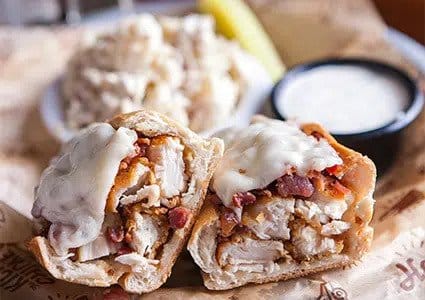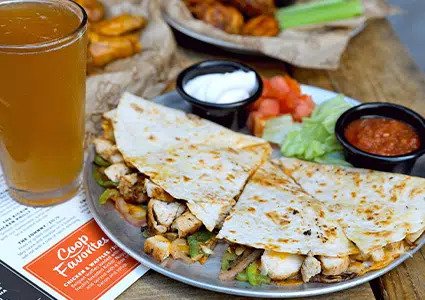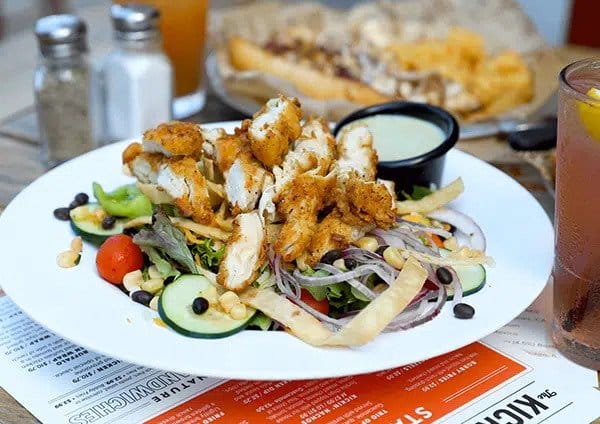Sports Bar in Downtown Charleston, SC

We'd like to welcome you the coolest coop in Downtown Charleston: The Kickin' Chicken. Life in the Lowcountry is all about laid-back vibes and fun times, and we serve up those same experiences alongside our famous coop favorites seven days a week.
Whether you're gathering friends and family for game day or want a fresh, fast dinner for the two of you, we've got something to meet everyone's needs. Downtown Charleston residents love to eat at our restaurants because we know what they like to eat, drink, and play. No, we didn't conduct surveys and focus groups to get that conclusion - owners Chip Roberts and Bobby Perry grew up right here in Charleston. Like many Chucktown natives, they attended the University of South Carolina before finding their path in life.
After graduating college, Chip and Bobby saw a chance to add to the delicious food culture in Charleston. In 1997, Bobby and Chip partnered up to start Charleston's favorite bar and grill: The Kickin' Chicken. If you've ever visited our restaurant, you know it was never meant to be a fancy, sit-down eatery. Instead, Chip and Bobby envisioned serving fresh, delicious food to their fellow Charlestonians in a fun and enjoyable atmosphere.
After opening their first location in Charleston, Bobby and Chip knew they had something special on their hands. After building a loyal fanbase and experimenting with the recipe for its now-famous Kickin' Chicken sandwich, it was time to expand.
To help facilitate that expansion, David Miller came onboard after they opened a second location. Finally, with the guidance and knowledge that David brought, the Kickin' Chicken had become a staple in South Carolina and an incredibly popular sports bar in Downtown Charleston, SC.
Today, we're still cooking up fresh, tasty meals and great times at all our locations around metro Downtown Charleston. We're proud to be Lowcountry natives and strive for excellence with every plate and drink we deliver to your table or front door.
Our hours
| Day | Hour |
|---|---|
| Sunday - Thursday | 11 am -10 pm |
| Friday - Saturday | 11 am - 11 pm |
Welcome to Your New Favorite Bar and Grill in Downtown Charleston, SC
Our sports bar wouldn't be what it is without a menu full of coop favorites, signature sandwiches, and cold beverages. Here are just a few of our customer's go-to dishes and drinks to enjoy at Kickin' Chicken:
Starters
They say first impressions make a world of difference. Our starters are sure to whet your appetite and show your stomach how serious we are about making it happy.

Bobby Fries
"I'll just eat half of those Bobby Fries now, and I'll save the rest for later," is a phrase that nobody says. Why? Because our Bobby Fries are basically heaven on earth, and it's almost impossible to put them down. We start with sizzling, fresh fries hot out of the fryer and top them with creamy ranch dressing, crispy bacon bits, and a blanket of melted cheeses. We then serve them straight to your table or house, so you can dig in even if you're not dining out.

Fried Pickles
Lightly breaded and fried to golden-brown perfection, our fried pickles are equal parts tangy and tasty. With a cup of cool ranch served on the side, it's hard to quit dipping these crispy pickle chips. Order up a batch or two to enjoy with friends on college gameday or as a precursor to your memorable meal at Kickin' Chicken.

Kickin' Nachos
Get ready for one of the biggest, best plates of nachos that you've ever seen in a Downtown Charleston sports bar. We start with a heaping helping of crispy, crunchy tortilla chips and top them with our indulgent house queso. We then add melty mixed cheese, crisp lettuce, cool tomato, onion to the mix, so you can say you ate your veggies. We top it all off with zesty jalapenos for a little extra kick.
Chicken, Rubs, & Sauces
Our chicken dishes helped put us on the map, so be sure you try one or all of our fresh-made choices of fried poultry perfection.

Wings
Whether you're "winging" in the weekend or need football-day food for your whole crew at the bar, our famous chicken wings are a crowd favorite at Kickin' Chicken. Hot and crispy on the outside and tender and juicy inside, you can't go wrong with fried chicken wings, especially when friends are near and sports is on the TV. Sauce up your wings with flavors like buffalo, Nashville hot, hot honey garlic, Polynesian, or pterodactyl. Or, if you prefer, let us rub your meat with lemon pepper, ranch, spicy ranch, or Jamaican jerk. The choice is yours, and none of them are wrong.

Kickin' Nuggets
A world without great chicken nuggets is a world we don't want to live in. That's why we made our own! Our fresh-cut, hand-breaded, all-white meat nuggets are served with fries and your choice of honey mustard or ranch for dipping.

Kickin' Tenders
Our marinated chicken tenders are big, juicy, and hand-breaded in our unique blend of spices. You won't find these plump tenders at any fast-food drive-thru! Before we deliver your Kickin' Tenders, we load up your plate with crispy fries and add a cup of honey mustard for dipping. Concerned about your cardio? Order your tenders grilled instead of fried!
Signature Wraps & Sandwiches
Our Kickin' Chicken wraps and sandwiches are handheld masterpieces that will leave your tummy full of joy.

The Kickin' Chicken
This sandwich is the one that started it all! We pile tender, juicy chicken and crispy bacon into a soft sandwich roll and cover it with a melty blanket of provolone cheese. With a side of our extra-special sauce for dipping, this is chicken sandwich nirvana that you can only find at our bar and grill in Downtown Charleston, SC.

The Johnny
Want to take your Kickin' Chicken to the next level? Our The Johnny takes all the best things about our original version and adds that spicy tang that you're craving. This fan-favorite comes with your choice of french fries, pasta salad, coleslaw, or potato chips, complete with ranch or bleu cheese for dipping.

Boss Burger
Cheddar cheese, onion straws, lettuce, tomato, smoky BBQ aioli.
Coop Favorites
Like the famous Kickin' Chicken sandwich, our Coop Favorites are uniquely us and full of Lowcountry love and flair.

Kickin' Quesadilla
In "queso" you didn't know, you can sponsor your good mood with our take on this classic bar food staple! We take your pick of chicken, shrimp, or veggies, add mixed cheese, onions, and peppers, and grill it to perfection. We then deliver it to your door or table with fresh salsa and yummy sour cream to complete this masterpiece.

Chicken & Waffles
Crispy fried chicken. Pillowy-soft Belgian waffles. A side of salty bacon and sweet syrup. Breakfast for dinner never sounded so great!
Salads
Our salads are tasty, lean, and green to help your body keep running like a machine. With unique salad dressings and awesome add-ons, your new favorite dish might just be doctor recommended.

The Southwest Salad
Our house salad topped with black bean & corn mix, and tortilla crisps. Served with our creamy cilantro lime. Add Chicken $5, Shrimp $6, Veggie Burger $5.

The Kickin' Chicken Salad
A refreshing salad topped with your choice of fried or grilled chicken, this salad is far from rabbit food, and will leave you feeling full without having to unbutton your pants.
Latest News in Downtown Charleston, SC
Folly Beach celebrates 50 years as a city
Chelsea Grinsteadhttps://charlestoncitypaper.com/2023/09/15/folly-beach-celebrates-50-years-as-a-city/
Turning 50 years old isn’t just a major milestone for people. But for a community — especially one on the edge of America? It’s a pretty big deal.The city of Folly Beach will celebrate its 50th anniversary Sept. 22 to Oct. 1 with a series of fun community events.“It’s not a sleepy little beach town anymore,” said Mark Patrick, an assistant director for Charleston County Parks and Recreation. “It’s a vibrant part of Charleston on a daily basis.”The calendar of events i...
Turning 50 years old isn’t just a major milestone for people. But for a community — especially one on the edge of America? It’s a pretty big deal.
The city of Folly Beach will celebrate its 50th anniversary Sept. 22 to Oct. 1 with a series of fun community events.
“It’s not a sleepy little beach town anymore,” said Mark Patrick, an assistant director for Charleston County Parks and Recreation. “It’s a vibrant part of Charleston on a daily basis.”
The calendar of events includes a 1920s-themed black tie gala on Sept. 22 at the Tides hotel with a formal dinner, craft cocktails and live music. The next day, a fleet of cars will take over Center Street for an outdoor car show, and local bars will represent a different decade with food and drink offerings. The Sept. 23 festival also includes vendors, food, drinks and live music on three stages, plus a Ferris wheel and carousel.
Head to the beachfront from 3rd West Street to the Tides to enjoy beach games from 11 a.m to 3 p.m. Sept. 24 with bocce, volleyball and kids’ activities before the after-party kicks off with live music and drink specials. For a full calendar of events, go to visitfolly.com/50-years-of-folly.
Patrick started working for the parks department on the island in 2011 and has seen the city flourish in both culture and business, he said. Folly Beach County Park has been a staple for residents and visitors for decades, and the Folly Beach Pier, which was originally built in 1995, has become iconic.
“The pier instantly became a Charleston landmark,” Patrick said, “and that version of the pier was great for its 25 years of service before it closed in 2021. The new pier opened last December, and it’s been very well received and is making its own place in the Charleston area.
“You never knew on a daily basis what you were going to encounter out there,” Patrick said.“There’s always something exciting going on in Folly Beach and that’s the way it’s always been.”
Folly Beach city councilman D.J. Rich has operated Planet Follywood eatery and bar since 2005.
“My favorite memories of Folly are pre-Follywood, pre-hotels, pre-stop lights,” Rich told the Charleston City Paper.
Some of his favorite memories include crabbing with his grandfather under the Atlantic House, learning to shoot pool at the old tackle shop and climbing rocks with his brother on the beach to watch the waves crash.
“I love being a part of this community,” he said. “I love being able to help steer the city as a member of the city council. Everything progresses, and change is inevitable, I get it. But it would be nice to go back to simpler times.”
For Rich, Folly Beach is a mecca for diversity and relaxation.
“Folly Beach is special because it is a melting pot,” he said. “The community is very diverse and relaxed. You could be sitting at the bar next to a multi-millionaire and a surf bum and may not be able to tell who is who.
“We have surfers, musicians, doctors, first responders, freaks, geeks and everything in between. It’s a very eclectic mix of culture, background and history. This community has always been willing to give, no matter the cause. We take care of each other.”
Love Best of Charleston?
Help the Charleston City Paper keep Best of Charleston going every year with a donation. Or sign up to become a member of the Charleston City Paper club.
Former FIG chef to lead culinary operations at 2 forthcoming Charleston restaurants
Parker Milnerhttps://www.postandcourier.com/food/former-fig-chef-to-lead-culinary-operations-at-2-forthcoming-charleston-restaurants/article_8e30327e-51b3-11ee-9739-ff7563262104.html
When an opportunity that Jason Stanhope says “checked every box” first came up, the longtime FIG executive chef set a meeting with owners Mike Lata and Adam Nemirow. Stanhope, who joined FIG in his 20s, valued the opinions of the bosses who became friends during his 15-year tenure at the ...
When an opportunity that Jason Stanhope says “checked every box” first came up, the longtime FIG executive chef set a meeting with owners Mike Lata and Adam Nemirow. Stanhope, who joined FIG in his 20s, valued the opinions of the bosses who became friends during his 15-year tenure at the celebrated Meeting Street restaurant.
They supported Stanhope’s decision to move on from the place that revived his love of cooking and helped him win a James Beard Award. As difficult as it was to leave FIG, the chance to work for “a gritty, scrappy company” with an established presence in Charleston was one Stanhope could not turn away.
“I don’t have a single regret from my time at FIG,” Stanhope said. “I’m not done cooking. I really wanted to capture this moment.”
The 41-year-old chef will soon have the chance to put his stamp on Charleston’s dining scene as the chef partner of two neighboring peninsula restaurants, both of which are located on The Pinch Charleston’s boutique hotel property and owned by Philadelphia-based real estate and hospitality company Method Co.
One of the restaurants, The Quinte, is a familiar name to local diners who stopped by for scallops and black bass with ham gel earlier this year. The oyster bar, which operated on the 40 George St. property for eight months before temporarily closing in June, will feature a similar selection of local seafood upon its reopening. Stanhope plans to make the menu more robust, offering guests a place to visit for a full meal.
The second dining venue, Lowland, will be The Pinch Charleston’s flagship restaurant. Located inside a carriage house with salvaged archways and doors, Lowland will be home to a tavern, parlor room and a swanky upstairs dining room with its own private bar. The space features art, plants and thoughtful lighting, a 100-plus seat setting Stanhope said inspired him.
“We are welcoming people in our home,” Stanhope said. “It will come with all the trimmings of the best dinner party in town.”
The chef is keeping the forthcoming food menu at Lowland under wraps, though he does plan to serve a tavern burger, grilled local fish, plenty of local vegetables and perhaps a savory pie. Overall, Lowland will be a “deluxe Southern tavern with an oyster and Champagne bar,” said Stanhope, who will spend time behind the burners at both restaurants when they open simultaneously in November.
In addition to The Pinch, Method Co. is the group behind the upcoming project across the street from Charleston’s former Morris Sokol Furniture storefront, a hotel that will feature a dining component. While the hotel is still in the early stages of development, Stanhope would be behind any food service element under his new role as chef partner of Method Co.’s Charleston properties.
Stanhope is looking forward to his future with the company, a partnership that he says is going to buy him more time to cook. According to the chef, renovations are complete at both The Quinte and Lowland, meaning the next two months will be spent staffing up and building the menus.
Restaurants serving oysters are plentiful in Charleston.
From casual counter service to white tablecloth fine dining, here are a few places to start your journey:
167 Raw
193 King St., downtown Charleston
In 2014, College of Charleston alumnus Jesse Sandole opened 167 Raw as an extension of his family’s seafood market at 167 Hummock Pond Road in Nantucket, Mass. The restaurant served lobster rolls, ceviche, raw and fried oysters, pastrami-style swordfish and more. It relocated to King Street in 2020. 167 Sushi Bar now resides in its old East Bay Street location.
Bowens Island Restaurant
1870 Bowens Island Road, James Island
It’s hard to argue with an evening at this spot five minutes from Folly Beach. Enjoy cold beer and fresh oysters picked from the waters surrounding the 13-acre island daily while watching the sunset.
The 75-year-old establishment, declared a James Beard Foundation American Classic, is an essential introduction to steamed oysters. But don’t expect white tablecloth service. At Bowens, piles of oysters are dumped onto half or full trays, and guests are handed oyster knives for self-shucking. This, and the unmatched setting, makes a meal here an immersive experience and prerequisite to a classic Lowcountry oyster roast.
Chubby Fish
252 Coming St., downtown Charleston
Chef/owner James London features what could be described as a locally focused oyster-on-the-half-shell offering, with four of the six options coming from South Carolina.
Developing strong relationships with local purveyors has helped London bolster his supply. Steamboat Creek Oyster Farm, Barrier Island Oyster Co. and Braden Oyster Farm are among the farms London works with consistently.
Delaney Oyster House
115 Calhoun St., downtown Charleston
Delaney’s offers a rotating selection of oysters that are refreshingly cold and without a speck of shell to pollute their cleanly shucked meat. Even better, the varieties are clearly labeled with tags affixed to bamboo picks. Delaney offers at least six types of fresh oysters, along with peel-and-eat shrimp and caviar and a variety of small and large cooked seafood plates.
Fleet Landing Restaurant & Bar
186 Concord St., downtown Charleston
Fleet Landing is owned by Tradd and Weesie Newton and is housed in a 1940s-era naval debarkation building. It might just be the only downtown oyster-serving waterfront restaurant. Visited by the likes of celebrity chef Andrew Zimmern, Fleet Landing serves oysters on the half-shell with house-made cocktail sauce.
Behre: Leaning into Charleston’s old history outside the Custom House
Robert Behrehttps://www.postandcourier.com/opinion/commentary/behre-leaning-into-charlestons-old-history-outside-the-custom-house/article_45651e90-51b0-11ee-b829-df04202f8ba5.html
Most people probably never noticed how a monumental light post outside the U.S. Custom House leans a bit to the north, but new research has found the probable cause — and tells us something exciting about Charleston’s earliest history.The discovery was made by Alexis Allen, who grew up in Kansas but moved to Charleston to enroll in Clemson’s Historic Preservation master’s program. For her senior thesis she mixed preservation with another academic interest: archaeology.Allen and a few classmates took grou...
Most people probably never noticed how a monumental light post outside the U.S. Custom House leans a bit to the north, but new research has found the probable cause — and tells us something exciting about Charleston’s earliest history.
The discovery was made by Alexis Allen, who grew up in Kansas but moved to Charleston to enroll in Clemson’s Historic Preservation master’s program. For her senior thesis she mixed preservation with another academic interest: archaeology.
Allen and a few classmates took ground-penetrating radar readings at four sites around downtown Charleston where the oldest maps and plats indicate its original walls once stood.
These walls were begun around 1704, when Charles Towne sat on England’s colonial frontier, vulnerable to attack by France and Spain. The walls came down later in the 18th century, as military strategy evolved, tensions eased and the city needed room to grow.
Today, there are few places to see what little remains: The best place is in the basement of the Old Exchange building, where archaeologists unearthed a portion of the original wall’s half-moon battery decades ago. A small sign points out the 300-year-old bricks.
The precise location of much of the rest remains a mystery, though then-Charleston Mayor Joe Riley created a Walled City Task Force in 2005 to, among other things, stir interest in finding more of it.
At least one member of the task force, Katherine Pemberton, was Allen’s thesis adviser and helped her research the city’s earliest maps to decide where the most fruitful spots might be to use ground-penetrating radar to search for the wall, which generally followed where East Bay, Cumberland, Meeting and Tradd streets are today.
At two of the examined sites, on Meeting and Cumberland streets, she essentially found nothing. That’s probably because only the wall along the Cooper River was built with brick and mortar; the three other sides were constructed of dirt and wood. That makes remnants harder to find, particularly after so many generations of new buildings and utility lines.
Deciphering the radar results is tough enough to begin with, as the machine produces only a series of black and white waves that often need careful interpretation after the field work is done.
Allen knew the most promising of her four locations was the street and sidewalk outside the Custom House, the general site of a massive diamond-shaped bastion. A historical marker for the Craven Bastion is attached to the other monumental light post (the one not leaning so much).
She got excited when the readout seemed consistent with what she expected: a flat, rectangular-shaped remnant of masonry about two feet underground. When the walls were dismantled later in the 18th century, the above-ground brick was salvaged and auctioned off, but the deepest few feet of the brick foundation remained in the ground.
“This could actually be something,” she remembers thinking. She also found something when she moved the machine toward the street, where the bastion transitioned into a curtail wall. “It just lines up perfectly.”
Another of her advisers was Craig Bennett, a structural engineer whose firm had been hired by the federal government to address the Custom House wall, which is settling in several spots. Allen says the lower portion of wall is undulating for other reasons, but the light post developed a northward lean because part of it rested on bricks from the bastion but the rest did not. Over time, the weight of all the stone settled unevenly.
Allen looked at the light post just last week, after its recent repair. “You can still see it lean a little bit, but it’s not as bad as it was.”
At her last site, a part on East Bay near Tradd, ground-penetrating radar readings also indicated a strong likelihood of a piece of the curtain wall.
She hopes her findings will guide future archaeology that can uncover the bricks and confirm what she found, though it’s unclear when that might be. The Craven Bastion was actually the last piece of fortification taken down, around the 1780s, when what today is Market Street was still a creek.
So while it’s unclear when an archaeological dig might expose the bastion’s bricks and confirm Andrews’ findings, she notes that many of the wall’s bricks are likely seen every day. When the wall was taken down, its bricks were auctioned off and reused in other buildings, she says, “but we don’t know which ones.”
“These bricks could be anywhere, and we don’t know it,” she says. “They’re somewhere out there.”
Click here for more opinion content from The Post and Courier.
Get a weekly recap of South Carolina opinion and analysis from The Post and Courier in your inbox on Monday evenings.
Editorial: Finally, a promising path, if not yet a bike lane, on King Street
THE EDITORIAL STAFFhttps://www.postandcourier.com/opinion/editorials/editorial-finally-a-promising-path-if-not-yet-a-bike-lane-on-king-street/article_604ff75c-5318-11ee-87c0-3f0cd73eccf9.html
Those familiar with how legislatures and city councils function often refer to their process as making sausage; it’s a durable metaphor because stuffing guts and other animal parts into an intestinal casing doesn’t look or sound appetizing at all but often creates something quite tasty in the end. In other words, the process behind government finding a consensus often appears ugly, but the result can be appealing.Charleston City Council must continue to make sausage on lower King Street.The S.C. Department of Transp...
Those familiar with how legislatures and city councils function often refer to their process as making sausage; it’s a durable metaphor because stuffing guts and other animal parts into an intestinal casing doesn’t look or sound appetizing at all but often creates something quite tasty in the end. In other words, the process behind government finding a consensus often appears ugly, but the result can be appealing.
Charleston City Council must continue to make sausage on lower King Street.
The S.C. Department of Transportation has recognized this street as among the most dangerous in the state for pedestrians and cyclists, but its recommendation to turn one of King Street’s two travel lanes into a buffered bike lane has generated pushback this year, particularly among business owners who wonder if there’s a better option.
The department then suggested one different way: combining the two travel lanes into a single, much wider lane that bicyclists and motorists could share. Unfortunately, many suggested that change would be just as dangerous as the status quo — maybe even more. Finding and vetting other ideas has been a frustratingly long ordeal, particularly since so many have a stake in the outcome, including business owners and residents along the street, property owners, delivery trucks and emergency responders who need access, bicyclists and, perhaps most importantly, the throngs of pedestrians who currently are most at risk.
To break the impasse, Mayor John Tecklenburg has been talking with state transportation officials and has outlined the best idea we’ve seen so far to resolve this. First and importantly, the city and state would proceed with all other recommended improvements for Meeting, St. Philip, Calhoun and King streets, such as traffic light timing upgrades, improved crosswalks and new signs that will make the city’s central business district a safer place for all.
As that moves forward, the city will continue to work on building a consensus for what to do about King, particularly its narrowest portion between Calhoun and Wentworth streets. Leaving it as it is should not be an option. It might turn out that the state’s buffered bike lane plan is the best step, but we don’t see the harm in the city’s continued work with interested parties to vet other options. Widening the sidewalks would cost more money than envisioned in these safety upgrades, but that could be the ultimate solution.
What’s important is that the city, state and other interested parties make the best use of the coming months, and don’t ignore this issue. We’re encouraged by Mr. Tecklenburg’s announcement that the state seems willing to test some changes with the understanding they can be reversed if they prove to be unpopular — or made permanent if there’s agreement they work. We urge the city and state to continue with that sort of flexible, commonsense approach. And we urge City Council to keep an open mind when it’s presented with options in the months ahead.
During this debate, Councilman William Dudley Gregorie reminded us that several years ago, the city faced controversy and pushback when it eliminated one of two traffic lanes around Hampton Park and gave that space to bikers and pedestrians. Mr. Gregorie was among those who didn’t like the idea, but he now admits it works well. As we’ve noted, this is new territory: For years, our state and local transportation departments prioritized motor traffic, not walking or biking. We’re glad to see that change, but change can be hard.
We are confident there is a better way to allocate space on lower King Street to make it a safer, better and more appealing street. And what’s ultimately important is that the city and state settle on a better solution, so we can all get past the frustratingly lengthy, convoluted process of finding it.
Click here for more opinion content from The Post and Courier.
Get a weekly recap of South Carolina opinion and analysis from The Post and Courier in your inbox on Monday evenings.
Charleston Co. delegation addresses flooding, stormwater concerns
Emily Johnsonhttps://www.live5news.com/2023/09/15/charleston-co-delegation-addresses-flooding-stormwater-concerns/
NORTH CHARLESTON, S.C. (WCSC) – The Charleston County Legislative Delegation hosted a Flood Prevention Taskforce Committee meeting Friday afternoon, bringing together public works representatives to address problems from throughout the state.The main topic of Friday’s meeting was the permitting process associated with stormwater outfall maintenance and what issues local governments are running into when it comes to receiving permits for large flooding-related projects.Rep. Leon Stavrinakis, and Sens. Sandy Senn and ...
NORTH CHARLESTON, S.C. (WCSC) – The Charleston County Legislative Delegation hosted a Flood Prevention Taskforce Committee meeting Friday afternoon, bringing together public works representatives to address problems from throughout the state.
The main topic of Friday’s meeting was the permitting process associated with stormwater outfall maintenance and what issues local governments are running into when it comes to receiving permits for large flooding-related projects.
Rep. Leon Stavrinakis, and Sens. Sandy Senn and Chip Campsen, hosted the meeting to have a group conversation with all 16 municipalities in Charleston County.
Topics discussed included permitting delays regarding the cleaning out outfalls, delays in permitting docks and other projects and the need to set deadlines for permitting.
“I think one of the worst things for the environment is having an outfall that doesn’t work,” Campsen says.
Friday was the first time the task force met in over a year, and members of the South Carolina Department of Health and Environmental Control and the Army Corps of Engineers answered questions from representatives about what can be done to make these projects move along faster.
“There’s a lot of money coming down on the state and federal levels to provide funding for stormwater projects, and we want to make sure that the projects can get off the ground, and completed in a timely fashion before the funds expire,” Charleston County Legislative Delegation Flooding and Public Works Coordinator Phillip Sexton says.
“We just want to have an open dialogue with the agencies that review the permitting, and make sure that they are ready to get that slug of permit requests that are going to be coming down the pipeline here soon,” he adds.
The task force, which was created back in 2018, has helped over 400 constituents in Charleston County with their stormwater or flooding concerns.
“It is a resource out there to the citizens against issues with Charleston County, and the reason is that this flooding is not going away,” Sexton says. “I think we see that this has become somewhat of the new norm here in the Lowcountry, and as citizens of the county, we need to kind of learn to live with it to a certain extent; but also, if you have issues or concerns, we’re a resource that you can bring it up to.”
If you are experiencing problems with flooding or stormwater drainage, you submit a flood prevention application with the delegation.
Copyright 2023 WCSC. All rights reserved.
Disclaimer:


